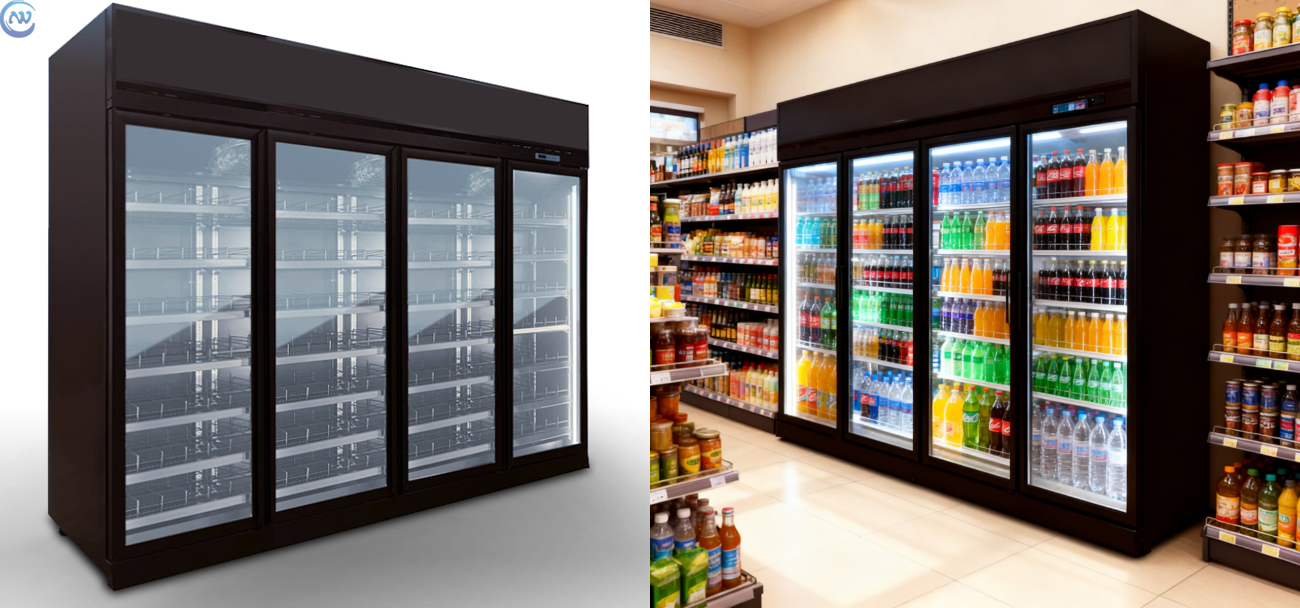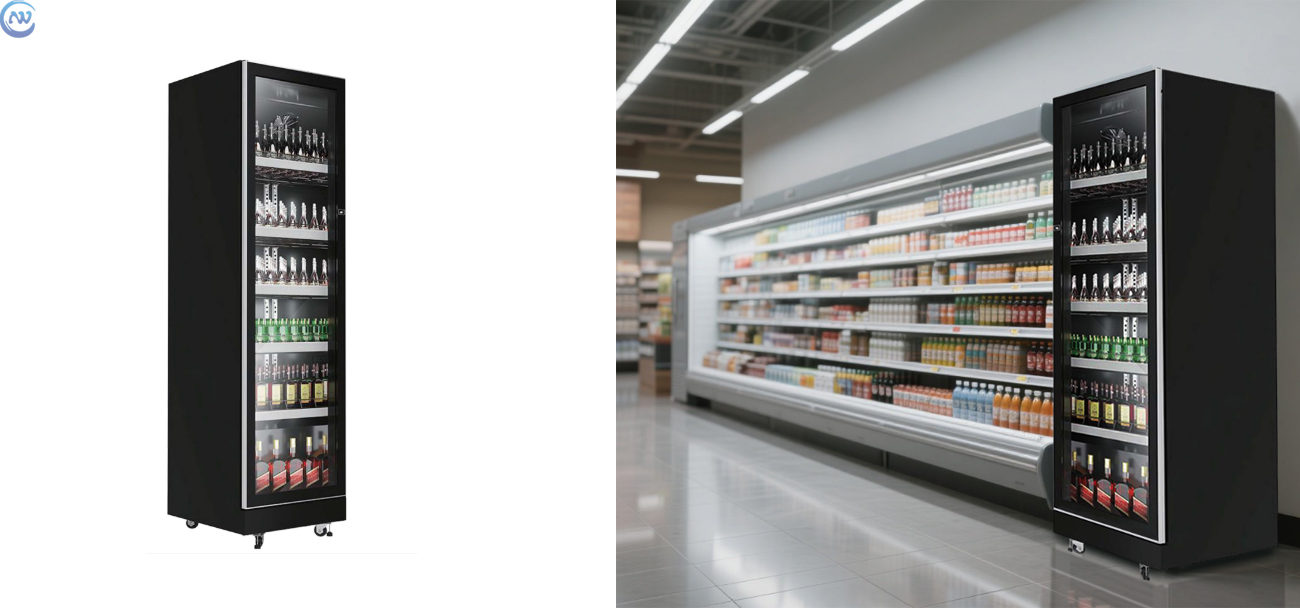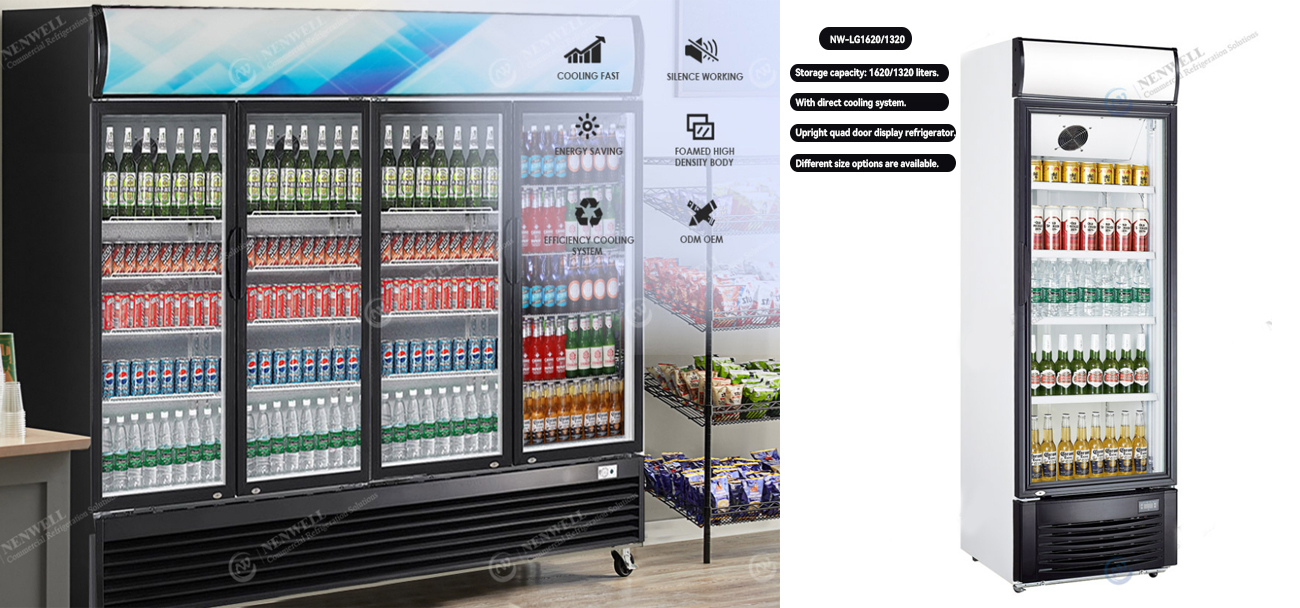The choice of air cooling and direct cooling in supermarket beverage cabinet should be comprehensively considered based on the use scenario, maintenance needs and budget. Generally, most shopping malls use air cooling and most households use direct cooling. Why is this choice? The following is a detailed analysis.
1. Core Performance Comparison (Details Table)
|
dimension |
Air-cooled beverage cabinet |
Direct-cool beverage cabinet |
|
Principle of Refrigeration |
The rapid cooling is achieved by forcing the cold air to circulate through the fan. |
The cooling speed is slow by evaporator natural convection. |
|
temperature homogeneity |
The temperature fluctuates within ±1℃, with no refrigeration dead corners. |
The temperature near the evaporator area is low, and the edge is higher. The temperature difference can reach ±3℃. |
|
Frosting |
No frost design, automatic defrosting system defrost and drain regularly. |
The surface of the evaporator is prone to frost, so manual defrosting is required every 1-2 weeks, otherwise the refrigeration efficiency will be affected. |
|
Moisturizing effect |
Fan circulation reduces air humidity and may slightly dry the surface of the drink (moisture retention technology is available in high-end models). |
Natural convection reduces water loss, suitable for juice and dairy products sensitive to humidity. |
|
Power consumption and noise |
The average daily power consumption is 1.2-1.5 KWH (200-litre model), and the fan noise is about 35-38 decibels. |
The average daily power consumption is 0.5-0.6 KWH, and there is no fan noise only about 34 decibels. |
|
Price and Maintenance |
The price is 30%-50% higher, but maintenance is free; the complex structure leads to slightly higher failure rate. |
The price is low, the structure is simple and easy to maintain, but it needs regular manual defrosting. |
As can be seen from the above table, the core features of air cooling and direct cooling are listed below for different scenarios to select the configuration according to the core dimension:
(1) Air-cooled type
It is easy to see from the above performance table that the biggest advantage of air cooling is that it is not easy to frost, while supermarkets and convenience stores need to focus on refrigeration and display effect, so frost can not meet the display of beverages, so the air cooling type display cabinet is the best choice.
Moreover, in high-traffic venues like supermarkets, air-cooled displays can rapidly cool down to prevent beverages from warming. For example, the Nenwell NW-KLG750 air-cooled display cabinet maintains a temperature difference of no more than 1℃ through its three-dimensional airflow system, making it ideal for displaying temperature-sensitive items like carbonated drinks and beer.
There are also many large-capacity models available. The NW-KLG2508 features four-door access and a massive 2000L capacity, with its forced circulation system designed to cover larger spaces. For example, the Haier 650L air-cooled display cabinet supports precise temperature control ranging from-1℃ to 8℃.
For small convenience stores, the NW-LSC420G single-door beverage cabinet is an ideal choice. Featuring a 420L capacity air-cooled unit, it maintains a consistent refrigeration temperature of 5-8°C after 120 door cycles during 24-hour testing.
(2)Select direct cooling scenarios
Direct-cooling beverage cabinets are budget-friendly, making them ideal for households with tight budgets. These units deliver excellent value for money, with Nenwell’s single-door direct-cooling cabinet being 40% cheaper than air-cooled models.
In addition, the main demand of household refrigeration is refrigeration and energy saving effect, a small amount of frost does not affect much, and the frequency of household door opening is low, the temperature is stable and the noise is small.
2.matters need attention
We need to pay attention to the maintenance of beverage cabinets and the differences between different brands. The specific analysis is as follows:
1. Maintenance: Determine the “Life and Energy Efficiency” of Beverage Cabinets
The failure of beverage cabinets is mostly due to long-term neglect of maintenance, and the core maintenance points focus on “refrigeration efficiency” and “equipment wear and tear”.
(1)Basic cleaning (once a week)
Clean glass door stains (to avoid affecting the display), wipe the water in the cabinet (to prevent the cabinet from rusting), clean the condenser filter (dust will slow down the refrigeration and increase power consumption);
(2)Core component maintenance (once a month)
Check the door seal integrity (air leakage may reduce cooling efficiency by 30%; use a paper strip test —— if the paper strip cannot be pulled after closing the door, it is qualified), and inspect the compressor noise (abnormal noise may indicate poor heat dissipation, requiring cleaning of debris around the compressor).
(3)Long-term precautions
Avoid frequent door opening and closing (each opening increases cabinet temperature by 5-8℃, increasing compressor load), do not stack drinks beyond capacity (deformed shelves may compress internal pipes, causing refrigerant leakage), and do not force door opening during power outages (maintain low cabinet temperature to reduce food spoilage risk).
3. Brand differentiation: The key lies in “positioning and details”
Brand differentiation is not merely about price, but rather about “priority of demand” (such as pursuing cost-effectiveness, valuing durability, or requiring customized services). Common differences can be categorized into three types:
|
Dimensional variation |
Mid-to-low-end brands (e.g., local niche brands) |
Mid-to-high-end brands (e.g., Haier, Siemens, Newell) |
|
Core Performance |
The cooling rate is slow (it takes 1-2 hours to cool down to 2℃), and the temperature control accuracy is ±2℃ |
Cools fast (down to target temperature in 30 minutes), temperature control ±0.5℃ (ideal for temperature-sensitive drinks) |
|
durability |
The compressor lasts 5-8 years, and the door seal is prone to aging (replace every 2-3 years) |
The compressor has a lifespan of 10-15 years, and the door seal is made of aging-resistant material (no need to replace after 5 years) |
|
accessorial service |
Slow after-sales service (3-7 days to arrive at the door) and no customization options |
24-hour after-sales service with customization options (e.g., brand logo printing, shelf height adjustment) |
The above is the main content of this issue, which is compiled based on the core needs of users. It is for reference only. The actual choice should be made based on various factors.
Post time: Oct-24-2025 Views:



